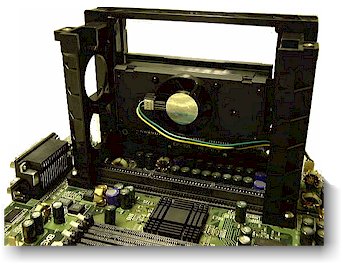Epox S2C Slot-1 to Slot-2 Adapter
by Anand Lal Shimpi on June 10, 1999 12:45 AM EST- Posted in
- Motherboards
While seemingly every motherboard manufacturer was busy releasing a Socket-370 to Slot-1 adapter, no one seemed to step back and ask the question, "what else can we do with this idea?" For those users looking to run dual Celerons the Socket-370 to Slot-1 adapter does make some sense as it can make running dual Celerons a bit easier. If you look at it from a price standpoint you are essentially buying a cheaper CPU (Socket-370 Celeron) and a converter card to run it in a more expensive motherboard (Slot-1) with the hopes that the prices of the more expensive CPUs (Pentium II/III) will come down and you will have a clean upgrade path to them. As far as saving money goes, you end up saving a few dollars at most because of the fact that the Celeron is already available in a Slot-1 flavor.
But what about the extremely expensive Slot-2 Xeon? Interestingly enough, only one motherboard manufacturer took the initiative to experiment with the idea of adapting a Slot-1 processor to a Slot-2 motherboard. That motherboard manufacturer? Epox. The product? The Slot-1 to Slot-2 adapter, the S2C.
The Problem and a Solution
The Slot-2 interface features the 330 pins the Pentium II/III Xeon processor plugs into, unfortunately this is a considerably longer interface than the 242 pins of the Slot-1 interface the Pentium II/III processor uses. With the Socket-370 Celeron converting it to a Slot-1 motherboard wasn't much of a problem and wasn't that difficult to imagine since the Celeron was originally designed for use with Slot-1 motherboards. The Xeon wasn't.
The connection between Slot-1 and Slot-2 exists in the system bus, both the Pentium II and Pentium II Xeon make use of a 64-bit wide bus known as the GTL+ that operates at a default of 100MHz. Since both processors use the same bus, couldn't it be assumed that they would be interchangeable if you could somehow bridge the pin gap? The 440GX chipset is available in both Slot-1 and Slot-2 versions, so it did seem as if the only limiting factor was the physical differences with the Slot-1 and Slot-2 connectors.

The Epox S2C bridges the gap between the two connectors as it essentially converts the 330 pins of the Slot-2 connector, to the 242 usable pins of the Slot-1 connector. The conversion is entirely electrical and involves no EEPROM or other functions of that sort, meaning that the conversion should work fine on all GX Slot-2 motherboards. Epox's documentation indicates that the solution is recommended only for Epox motherboards, however it should work fine with most Slot-2 GX (not NX) motherboards so long as there is BIOS support included for the Pentium II/III processors.
| The installation of the adapters is quite simple, plug them into your motherboard and plug your processors into the adapters. Epox does provide the user with a helpful installation guide that features helpful pictures that diagram the simple installation process. Keep in mind that you will need a case that supports Xeon processors if you plan on using these adapters since you must install the Xeon retention kit (provided with the SC-52) which does require a much greater vertical clearance than Slot-1 CPU retention kits. |  |
According to Epox, stability isn't compromised with the adapters installed, and AnandTech's tests did not reveal any stability problems nor any drop in performance while using the adapters and a pair of Pentium II 400 processors. Since the 66MHz FSB is not supported by default on any GX Xeon boards, the chances that you'll be able to use 66MHz FSB Pentium II processors without overclocking them is slim unless your board happens to support the 66MHz FSB.
Although it's not a revolutionary idea, this quick little solution is ideal for growing businesses or users that can't afford the incredible cost of Xeon processors now but want the ability to upgrade to a Xeon solution without tossing away their motherboard.










0 Comments
View All Comments